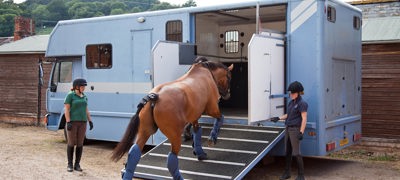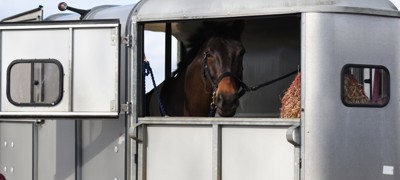- Safety first
- It is not recommended to travel horses in a trailer with the front top door in the hinged open position, due to the risk of injury to your horse from external objects entering the trailer.
- When lowering the ramp stand to one side so you are not under the ramp when it descends.
- If the trailer has a front ramp, opening it whilst loading can make loading more inviting. However, every horse is different so consider your horse’s behaviour and preferences.
- Make sure the jockey door is unlocked to exit through after loading.
- Ensure the breast bars are secure and at the correct height for your horse.
- Open the partition (from the rear in a trailer) to allow enough room for when you load.
- Some horses prefer to travel with some bedding down on the floor - absorbent material is ideal as it assists by soaking up urine when travelling.
- It is not recommended to travel horses in a trailer with the front top door in the hinged open position, due to the risk of injury to your horse from external objects entering the trailer.
- A friend on the ground to help can be beneficial.
- If your horse has never travelled before or is difficult to load, practice in a calm manner loading and unloading. The first journey for them should ideally be short to get them used to travelling.
When handling your horse we recommend you wear...
chevron-down
chevron-up
- A riding hat – with chin strap secured
- Sturdy footwear
- Gloves
Your horse should wear…
chevron-down
chevron-up
- A leather headcollar – leather breaks under stress
- Travel boots
- Tail bandage or guard
- Travel rug – weather dependent
Did you know…
chevron-down
chevron-up
Modern baler twine can have a breaking strain of 500kg or more!
You should always tie your horse up with a breakaway point, so if your horse does pull back, they do not cause injury. We recommend devices such as the Tether Tie, or a similar breakaway device. Alternatively, simply split your baler twine into a thinner piece.
Loading a horse
Control
chevron-down
chevron-up
We recommend loading a horse with a bridle over the leather headcollar. The bridle should be removed for your journey.
Trailers
chevron-down
chevron-up
If travelling one horse, load them on the right-hand side of the trailer. If travelling two horses, the heavier horse should be on the right. This helps with balance on corners.
Position
chevron-down
chevron-up
Position the horse facing straight at the ramp and walk them up the ramp.
Securing
chevron-down
chevron-up
- Secure the breach bar and/or partition – a friend on the ground is helpful for assisting.
- Tie the horse to your tether tie or baler twine using a quick release knot. The rope should be short enough that the horse cannot lower its head under the breast bar (trailer) or partition (horse box).
- Stand to the side and raise the ramp slowly, then secure all fastening.
Setting off
chevron-down
chevron-up
Check round the vehicle before you set off – ensure all doors and ramps are secure. Close the top front door on your trailer before travelling.
Unloading a horse
Arrival
chevron-down
chevron-up
On arrival, check your surroundings and then lower the ramp to the floor. Remember to stand to the side
Untying
chevron-down
chevron-up
Untie your horse and place the bridle on the horse before you undo the breast/breach bar or open the partition. Ensure you are in control. Don’t allow the horse to rush down the ramp.
Leaving unattended
chevron-down
chevron-up
If you have to leave your horse unattended on your transport for a short time, we advise you leave the ramps closed. Leave your contact details in a visible place such as the windscreen in case of an emergency.
Look after your transport
- Remove any droppings, urine, soiled bedding or debris after each use and allow the floor to dry. This helps prevent rot or corrosion to the floor.
- If you notice any defects when checking your transport have your transport professionally checked.
- Be cautious when cleaning with water, this can enter side panels or affect wooden flooring stability. If cleaning, lift any rubber matting, sweep off standing water and allow to dry in a well-ventilated place before replacing the mats and shutting the ramps.
Vehicle security
chevron-down
chevron-up
- Attach your security device when the vehicle is not in use. A hitch lock or wheel clamp for trailers, or a steering wheel lock for horseboxes is helps prevent theft.
- Vehicle GPS trackers can be added to vehicles for enhanced security.
- Check if your vehicle has an immobiliser fitted. If not, they can be professionally fitted by reputable mechanics.
- At a show, consider your vehicle security. Can you lock valuables away? Secure the ramps and lock the vehicle before leaving it unattended.






